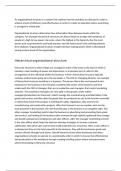Essay
*NEW* Unit 1 Exploring Businesses Learning Aim A P3: Explore the organisation structures, aims and objectives of two contrasting businesses.
- Module
- Unit 1 - Exploring Business
- Institution
- PEARSON (PEARSON)
*Certified Distinction Graded Work*: Includes - Learning aim B: Investigate how businesses are organised B1 Structure and organisation • Organisational structure, e.g. hierarchical, flat, matrix, holacratic. • Functional/operational areas, e.g. human resources, research and development, sale...
[Show more]



